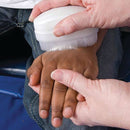Description
Patricia Wilbarger, MEd, OTR, FAOTA, developed the Wilbarger Protocol and the Wilbarger therapeutic brush to reduce sensory and tactile defensiveness. Tactile defensiveness is common in children on the autism spectrum, as well as those with Sensory Processing Disorder. Sensitivity to touch can cause a fear or resistance to being touched, difficulty transitioning between activities, and/or lethargy.
There is not much documented research on the Wilbarger Protocol. However, many parents of children with Autism have reported seeing decreases in sensory defensiveness and anxiety as a result of using the Wilbarger brushing technique. Some of the benefits of the Wilbarger Protocol may include improved ability to transition between daily activities, improved attention span, a decreased fear or discomfort of being touched, enhanced coordination, and self-regulation.
The complete routine usually only takes 2-3 minutes. The first step in the therapy involves using the soft, plastic, Wilbarger sensory brush or therapressure Brush which is run over the child's skin, using very firm pressure; it is like a deep pressure massage. Brushing starts at the arms and works down to the feet. The face, chest, and stomach area are never brushed because these are sensitive areas that can cause adverse reactions. The brushing therapy is initially recommended every 2 hours while the child is awake. Therapists usually re-assess the level of brushing after two weeks. At that time they may modify the program. The brushing continues as long as the individual benefits from it.
After the brushing therapy, therapists may also prescribe gentle joint compressions to the shoulders, elbows, wrists, fingers, hips, knees/ankles, and sternum for a count of ten. Self-administration of joint compression may also be obtained by engaging in jumping-jacks, push-ups, or jumping on a trampoline.
Note: It is very important that the Wilbarger Protocol be followed properly. Parents wishing to try this therapeutic technique for their child with ASD or SPD should consult with an occupational therapist and receive proper training.







